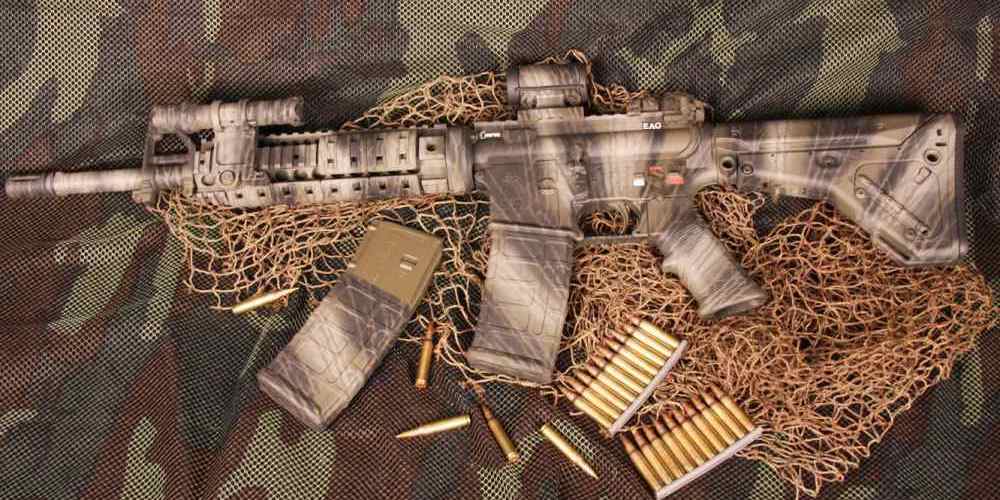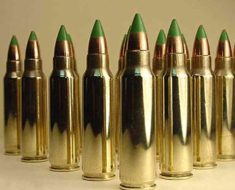“AR15 Ammo Ballistics: Precision and Power in every shot.”
Understanding AR15 Ammo Ballistics
When it comes to understanding AR15 ammo ballistics, there are a few key factors to consider. Ballistics refers to the science of projectiles in motion, including the behavior of bullets as they travel through the air. In the case of AR15 ammunition, it’s important to understand how different factors such as bullet weight, velocity, and trajectory can impact the performance of your rifle.
One of the most important aspects of AR15 ammo ballistics is bullet weight. The weight of a bullet is measured in grains, with heavier bullets typically offering better penetration and accuracy at longer distances. Lighter bullets, on the other hand, may travel faster but can be more easily affected by wind and other environmental factors. When choosing AR15 ammunition, it’s important to consider the intended use of your rifle and select a bullet weight that aligns with your shooting needs.
Velocity is another crucial factor in AR15 ammo ballistics. Velocity refers to the speed at which a bullet travels, typically measured in feet per second (fps). Higher velocity bullets can deliver more energy upon impact, resulting in greater stopping power and improved terminal performance. However, increased velocity can also lead to greater recoil and muzzle blast, which may impact your shooting accuracy. It’s important to find a balance between velocity and bullet weight to achieve optimal performance with your AR15 rifle.
Trajectory is also an important consideration when it comes to AR15 ammo ballistics. Trajectory refers to the path that a bullet takes as it travels through the air, influenced by factors such as bullet weight, velocity, and environmental conditions. Understanding the trajectory of your ammunition can help you make more accurate shots at different distances, as well as adjust for windage and elevation when shooting in varying conditions. By familiarizing yourself with the trajectory of your AR15 ammunition, you can improve your shooting accuracy and overall performance with your rifle.
In addition to bullet weight, velocity, and trajectory, it’s important to consider the type of ammunition you’re using in your AR15 rifle. There are a wide variety of AR15 ammunition options available, including full metal jacket (FMJ), hollow point, and soft point rounds. Each type of ammunition offers different performance characteristics, with FMJ rounds typically offering better penetration, while hollow point rounds are designed for maximum expansion upon impact. By selecting the right type of ammunition for your shooting needs, you can optimize the performance of your AR15 rifle and achieve better results on the range or in the field.
Overall, understanding AR15 ammo ballistics is essential for maximizing the performance of your rifle and achieving better shooting accuracy. By considering factors such as bullet weight, velocity, trajectory, and ammunition type, you can make informed decisions when selecting ammunition for your AR15 rifle. Whether you’re a seasoned shooter or new to the world of AR15 rifles, taking the time to learn about ballistics can help you improve your shooting skills and get the most out of your firearm. So next time you’re at the range, take a moment to consider the ballistics of your AR15 ammunition and see how it can impact your shooting performance.
Comparing Different Types of AR15 Ammo
When it comes to choosing the right ammunition for your AR15, there are a variety of factors to consider. One of the most important aspects to take into account is the ballistics of the ammunition. Understanding the ballistics of different types of AR15 ammo can help you make an informed decision about which type is best suited for your needs.
One of the key factors to consider when comparing different types of AR15 ammo is the weight of the bullet. The weight of the bullet can have a significant impact on its trajectory and terminal performance. Heavier bullets tend to have better penetration and are more effective at longer ranges, while lighter bullets may have higher velocities and flatter trajectories.

Another important factor to consider is the velocity of the bullet. The velocity of the bullet refers to the speed at which it travels downrange. Higher velocity bullets tend to have flatter trajectories and are less affected by wind drift. However, higher velocity bullets may also have more recoil and muzzle blast.
In addition to weight and velocity, the shape of the bullet can also impact its ballistics. Bullets with a more aerodynamic shape, such as boat-tail bullets, tend to have better long-range performance and are less affected by wind drift. On the other hand, bullets with a flat base may have better terminal performance at shorter ranges.
When comparing different types of AR15 ammo, it is also important to consider the ballistic coefficient of the bullet. The ballistic coefficient is a measure of how well a bullet retains its velocity and energy downrange. Bullets with a higher ballistic coefficient tend to have better long-range performance and are less affected by air resistance.
It is also important to consider the type of bullet construction when comparing different types of AR15 ammo. Full metal jacket bullets are typically used for target shooting and training, as they offer good penetration and are less likely to fragment upon impact. On the other hand, hollow point bullets are designed for self-defense and hunting, as they expand upon impact and create a larger wound cavity.
When comparing different types of AR15 ammo, it is important to consider your intended use for the ammunition. If you are primarily using your AR15 for target shooting and training, you may want to opt for a heavier, higher velocity bullet with a high ballistic coefficient. On the other hand, if you are using your AR15 for self-defense or hunting, you may want to choose a bullet with a hollow point design for maximum terminal performance.
In conclusion, understanding the ballistics of different types of AR15 ammo is essential for making an informed decision about which type is best suited for your needs. By considering factors such as bullet weight, velocity, shape, ballistic coefficient, and construction, you can choose the right ammunition to optimize the performance of your AR15. Whether you are a target shooter, hunter, or self-defense enthusiast, selecting the right AR15 ammo can make all the difference in your shooting experience.
How Barrel Length Affects AR15 Ammo Ballistics
When it comes to understanding AR15 ammo ballistics, one important factor to consider is how barrel length affects the performance of your ammunition. The length of the barrel on your AR15 can have a significant impact on the velocity, accuracy, and overall effectiveness of the rounds you are using. In this article, we will explore the relationship between barrel length and AR15 ammo ballistics, and provide you with the information you need to make informed decisions about your firearm.
Barrel length plays a crucial role in determining the velocity at which a bullet travels down the barrel and exits the muzzle. In general, a longer barrel will result in higher muzzle velocity, while a shorter barrel will produce lower muzzle velocity. This is due to the fact that a longer barrel allows for more time for the gunpowder to burn and propel the bullet forward, resulting in increased speed.
The increased velocity that comes with a longer barrel can have a number of benefits when it comes to AR15 ammo ballistics. Higher muzzle velocity can lead to greater accuracy at longer distances, as the bullet will have less time to drop and be affected by wind resistance. Additionally, higher velocity can also result in increased energy transfer upon impact, making the round more effective at stopping a threat.
On the other hand, a shorter barrel can also have its advantages when it comes to AR15 ammo ballistics. A shorter barrel is typically lighter and more maneuverable, making it easier to handle in tight spaces or for extended periods of time. Additionally, a shorter barrel can be more discreet and easier to conceal, making it a popular choice for those who prioritize stealth and portability.
It is important to note that while barrel length can have a significant impact on AR15 ammo ballistics, it is not the only factor to consider. The type of ammunition you are using, the twist rate of the barrel, and the quality of the firearm itself can all play a role in determining the performance of your rounds. It is important to consider all of these factors when selecting a barrel length for your AR15.
When choosing a barrel length for your AR15, it is important to consider your intended use for the firearm. If you are primarily using your AR15 for long-range shooting or hunting, a longer barrel may be the best option for you. However, if you are using your AR15 for close-quarters combat or home defense, a shorter barrel may be more suitable.
In conclusion, barrel length is an important factor to consider when it comes to AR15 ammo ballistics. The length of the barrel can have a significant impact on the velocity, accuracy, and overall effectiveness of your rounds. By understanding how barrel length affects AR15 ammo ballistics, you can make informed decisions about your firearm and optimize its performance for your specific needs.
Tips for Improving Accuracy with AR15 Ammo
When it comes to shooting with an AR15, understanding the ballistics of your ammo is crucial for achieving accuracy. Whether you are a seasoned shooter or a beginner, knowing the ins and outs of AR15 ammo ballistics can make a significant difference in your shooting performance. In this article, we will discuss some tips for improving accuracy with AR15 ammo.
One of the first things to consider when it comes to AR15 ammo ballistics is the type of ammunition you are using. Different types of ammo have different ballistic characteristics, such as bullet weight, velocity, and trajectory. It is essential to choose the right type of ammo for your shooting needs, whether you are target shooting, hunting, or engaging in competitive shooting.
Another important factor to consider is the grain weight of the bullet. The grain weight refers to the weight of the bullet in grains, with one grain equal to 1/7000th of a pound. Heavier bullets typically have better long-range accuracy and penetration, while lighter bullets may have higher velocity and flatter trajectories. Experimenting with different grain weights can help you find the right balance between accuracy and performance for your shooting needs.
Velocity is another critical factor in AR15 ammo ballistics. Velocity refers to the speed at which the bullet travels downrange and is measured in feet per second (fps). Higher velocity bullets tend to have flatter trajectories and better long-range accuracy, while lower velocity bullets may have more drop and drift. Understanding the velocity of your ammo can help you make adjustments to your shooting technique and equipment to improve accuracy.
Trajectory is also an essential consideration when it comes to AR15 ammo ballistics. Trajectory refers to the path that the bullet takes from the muzzle to the target and is influenced by factors such as bullet weight, velocity, and wind conditions. Understanding the trajectory of your ammo can help you make adjustments to your shooting technique, such as adjusting your sight picture or holdover, to compensate for bullet drop and drift.
Wind conditions can have a significant impact on the ballistics of your AR15 ammo. Wind can cause bullets to drift off course, affecting accuracy and precision. Understanding how wind affects your shooting can help you make adjustments to compensate for wind drift, such as holding off to one side or adjusting your aim point. Using a wind meter or observing environmental cues can help you make more accurate shots in windy conditions.
In conclusion, understanding the ballistics of your AR15 ammo is essential for improving accuracy and performance. By considering factors such as bullet weight, velocity, trajectory, and wind conditions, you can make adjustments to your shooting technique and equipment to achieve better results. Experimenting with different types of ammo and practicing regularly can help you become a more skilled and accurate shooter with your AR15. So next time you hit the range, remember these tips for improving accuracy with AR15 ammo and watch your shooting skills improve.
The Importance of Properly Storing AR15 Ammo
When it comes to owning an AR15 rifle, one of the most important aspects to consider is the type of ammunition you use. The ballistics of AR15 ammo can greatly impact the performance and accuracy of your rifle. Understanding the basics of AR15 ammo ballistics is crucial for any gun owner, whether you are a seasoned shooter or a beginner.
One key factor to consider when it comes to AR15 ammo ballistics is the type of bullet you are using. There are a variety of bullet types available for the AR15, including full metal jacket, hollow point, and soft point bullets. Each type of bullet has its own unique characteristics that can affect its trajectory, velocity, and impact on the target.
Another important aspect of AR15 ammo ballistics is the weight of the bullet. The weight of the bullet, measured in grains, can impact the velocity and energy of the bullet when it is fired. Heavier bullets typically have more energy and can travel at higher velocities, while lighter bullets may have less energy but can travel at faster speeds.
Properly storing your AR15 ammo is also crucial for maintaining its ballistics performance. Storing your ammo in a cool, dry place away from moisture and extreme temperatures can help prevent corrosion and ensure that your ammo remains in optimal condition. It is also important to store your ammo in a secure location to prevent unauthorized access and ensure safety.
In addition to proper storage, it is important to regularly inspect your AR15 ammo for any signs of damage or deterioration. Inspecting your ammo for dents, cracks, or discoloration can help prevent malfunctions and ensure that your rifle performs at its best. If you notice any damage to your ammo, it is best to dispose of it properly and replace it with new ammunition.
When it comes to shooting your AR15 rifle, understanding the ballistics of your ammo can help improve your accuracy and performance. Factors such as bullet type, weight, and velocity can all impact the trajectory of your shots and the effectiveness of your rifle. By familiarizing yourself with the ballistics of your AR15 ammo, you can make informed decisions about the type of ammunition you use and how you store and maintain it.
In conclusion, AR15 ammo ballistics play a crucial role in the performance and accuracy of your rifle. Understanding the basics of AR15 ammo ballistics, including bullet type, weight, and storage, can help you make informed decisions about your ammunition and improve your shooting skills. By properly storing and maintaining your AR15 ammo, you can ensure that your rifle performs at its best and remains safe to use.





